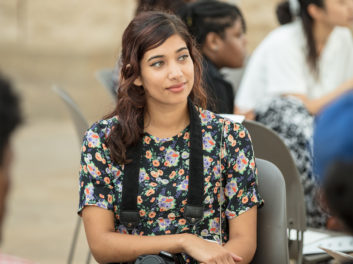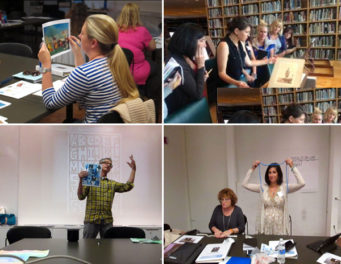Let’s talk about something scary: first real jobs. As the 2017 Multicultural Undergraduate Intern at the Getty Foundation this summer, I (and 20 other interns on the Getty campus) got a taste of what that first real job could feel like. The internships are full-time and paid, after all. But as fall begins and our time at the Getty concludes, one question looms large: what’s next?
To answer this question, I spoke with three former on-site Getty interns from recent years to get a glimpse of their “first real jobs.” Since it is Pacific Standard Time: LA/LA season (opening September 16!), I made a special point of talking to Getty interns who have gone on to work on PST: LA/LA so that I could share some behind-the-scenes insights about these exciting exhibitions.
Emily Butts
I first spoke with Emily Butts, who interned at 18th Street Arts Center in 2013 and then the Getty Foundation in 2015. Following her internships, Emily became curatorial assistant at the Los Angeles County Museum of Art (LACMA), where she worked on the PST: LA/LA exhibition Home—So Different, So Appealing, on view through October 15, 2017.
Emily helped with the daunting installation of Home, which included 97 artworks by 42 artists and spanned approximately 19,000 square feet of gallery space. According to Emily, it was an effort that could not have happened without constant collaboration between LACMA’s registration department, exhibition design team, exhibition coordinators, art prep and installation crew, construction workers, and graphic artists.
But her contributions to Home didn’t end there. “I’m considering adding another title to my resume—‘tortilla fairy!’” said Emily, who along with other staff members ensured that fresh tortillas were put out each day as part of Autoconstrucción, a large-scale installation by Mexican artist Abraham Cruzvillegas. “What may look to the everyday visitor as uncommonly fresh tortillas—ones that never mold, rot, harden, or fall—are tortillas that are replaced and heavily monitored,” says Emily. “Next time you see something perishable in a museum or gallery, think twice about who may come in after hours to freshen up the display. Please note that they are not up for grabs, even if you are hungry!”

Autoconstrucción (2010) by Abraham Cruzvillegas in Home—So Different, So Appealing at LACMA. Inset: A fresh stack of tortillas that are part of Autoconstrucción. Photos: Selene Preciado
This fall, Emily will pursue her master’s degree in art history, with a concentration in contemporary Latino and Latin American art, at University of Texas at Austin. She was recently awarded the Emerging Curator award from Los Angeles Contemporary Exhibitions and her show, Names Printed in Black, will be on view in January 2018.
Vanessa Arizmendi
At the Hammer Museum, Vanessa Arizmendi, a 2016 intern in the Getty Museum’s Paintings Department, has been busy working with an international curatorial team on the PST: LA/LA exhibition Radical Women: Latin American Art, 1960–1985, on view September 15 through December 31. The show features over 100 artists from 15 different countries across the Americas and gives visibility to the artistic practice of Latin American and US-born Latina women from 1960 to 1985, a pivotal time period for contemporary art and Latin America.

Featured in the Hammer’s Radical Women exhibition: Limitada, 1978, Marie Orensanz. 1/5 edition photography, 13 39/50 x 19 17/25 in. © Marie Orensanz. Courtesy of the artist
Along the way, Vanessa has learned about some of the challenges facing large-scale exhibitions that involve international loans. “With a show this size comes a lot of careful planning and we’ve often run into unforeseen obstacles when trying to acquire works from Latin American countries where institutions and governments operate differently,” says Vanessa. “Just recently, after years of coordinating a loan, we had to let go of a beautiful series of sculptures because the country’s political turmoil made export and travel impossible. It was sad to see that the political conditions against which many of these women worked could still hinder their ability to reach new audiences.”
However, Vanessa also recognizes that such obstacles make every small success feel like a major victory. “Seeing the catalogue for the first time was like seeing a beautiful homage to all these women, many of whom have not yet been recognized in an important way.”
Vanessa plans to work as project coordinator at the Hammer on its summer biennial, Made in L.A. 2018, before heading off to graduate school.
Joseph Daniel Valencia
In East L.A., Joseph Daniel Valencia has been working steadily as curatorial assistant on the Vincent Price Art Museum’s photography exhibition Laura Aguilar: Show and Tell, on view September 16 through February 10. In 2015, Joseph interned in the Getty Museum’s Department of Photographs, where he was involved in the iconic photography retrospective Robert Mapplethorpe: The Perfect Medium.

Former Getty Undergraduate Multicultural Intern Joseph Daniel Valencia stands outside of the Vincent Price Art Museum, where he works as curatorial assistant. Photo courtesy of Joseph Daniel Valencia
At VPAM, Joseph has been able to continue developing his curatorial skills in photography. One of the things he’s most proud of is learning how to navigate the complex waters of working with a living, contemporary artist.
“Laura Aguilar is so talented yet she has faced so many challenges. She’s a large-bodied woman and also has auditory dyslexia,” says Joseph. “Despite her challenges, she’s a great storyteller. Her voice is something we’ve been working hard to integrate into the exhibition as we install it. How do we make Laura’s voice present so that it’s not just the museum text explaining everything? How do we allow her to be an active participant in the exhibition? You don’t get to be involved in this kind of process if you’re not working with living artists.”
As a former Multicultural Undergraduate Intern, Joseph feels passionate about pursuing professional opportunities that expand the discourse for artistic practices and traditions that have arisen from a history of marginalization.
“The internship gave me institutional access and work experience at a level that I may have not had otherwise,” said Joseph. “With institutional hurdles in the U.S. making it difficult for underrepresented voices to remain within the walls of the museum, it is imperative for us to do whatever we can to ensure that we have a seat at the table. For me this means working hard, obtaining advanced degrees, and constantly supporting peers in an effort to build community and space for ourselves that will allow us to learn, grow, and lead.”
PST: LA/LA has inspired Joseph to keep contributing to transnational dialogues and research: “The biggest benefit to having these exhibitions is the scholarship that is produced—the books, catalogues, and publications that bring together work of scholars. I want to continue that.”
It was inspiring to see how these professionals have used their internships as launching pads for careers in the arts, especially in relation to PST: LA/LA. The internship program is producing scholars, professionals, and original research that has already begun to radically shift the arts discourse across Southern California and beyond. So, when I think about the question, “what’s next?” I feel confident, knowing that the arts hold many opportunities for me and my fellow interns as we look to the future.





Comments on this post are now closed.